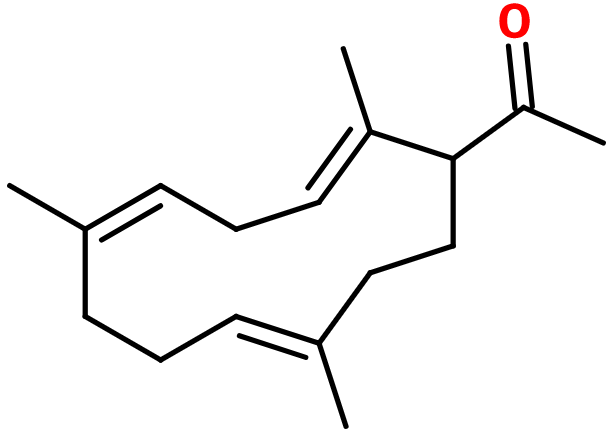Trimofix®
Synthétique
Woody > Ambery Woods > Cedar > Ambergris

Crédits photo: ScenTree SAS
Other names :
Cyclisone ; 1-(2,6,10-trimethyl-2,5,9-cyclododecatrien-1-yl) ethanone ; Fixamber ; Methyl-2,6,10-trimethylcyclododeca-2,5,9-trien-1-yl ketone ; Trimofix 0
Volatility :
Base
Uses in perfumery :
Trimofix® is used in woody notes and in male perfumes, to bring woody, ambery and dry power. It can be overdosed as it is sweeter than other woody-ambery materials.
Natural availability :
Trimofix® is not reported as found in nature, and can thus not be extracted from any plant.
Year of discovery :
1969
Other comments :
In the woody-ambery family, Trimofix® has a distinctive very dry note of sawdust, as Karanal® and Cedramber®.
Price Range :
€€€
Stability :
Stable in perfumes and various functionnal bases.

Crédits photo: ScenTree SAS
- Molecular formula :
- C17H26O
- Molecular Weight :
- 246,39 g/mol
- Density :
- 0,97
- Flash Point :
- >93°C
- Fusion Point :
- Donnée indisponible.
- Appearance :
- Colorless liquid
- Log P :
- Donnée indisponible,
- Boiling Point :
- Donnée indisponible.
- Detection Threshold :
- Donnée indisponible.
Synthesis route :
Synthesis of Trimofix® can be done starting from its corresponding trimethylcyclododecatriene, thanks to an acetylation reaction using acetic anhydride, in the presence of boron trifluoride diethyl ether.
Synthesis precursor :
Trimofix® is not a precursor for the synthesis of another material used in perfumery.
Isomerism :
Trimofix® has three double bonds. Their conformation does not matter for this compound. It is imposed during the synthesis and no isomer is favoured.
Trimofix® also is a constitutional isomer of Vertofix®, having a distinctive cedarwood smell.
- EINECS number :
- 248-995-2
- FEMA number :
- Donnée indisponible.
- JECFA number :
- Donnée indisponible.
- FLAVIS number :
- Donnée indisponible.
- Allergens :
- This ingredient does not contain any allergen.
- IFRA :
- This ingredient is restricted by IFRA
- Restriction type :
- RESTRICTION
- Cause of restriction :
- DERMAL SENSITIZATION AND SYSTEMIC TOXICITY
- Amendment :
- 49
- Quantitative limit on the use :
-
Cat.1 Cat.2 Cat.3 Cat.4 Cat.5A Cat.5B Cat.5C Cat.5D Cat.6 0,00016 % 0,13 % 0,4 % 2,4 % 0,6 % 0,52 % 0,6 % 0,17 % 0,00016 % Cat.7A Cat.7B Cat.8 Cat.9 Cat.10A Cat.10B Cat.11A Cat.11B Cat.12 0,87 % 0,87 % 0,17 % 2,2 % 2,2 % 4,4 % 0,17 % 0,17 % No Restriction - Restriction type :
- RESTRICTION
- Cause of restriction :
- DERMAL SENSITIZATION AND SYSTEMIC TOXICITY
- Amendment :
- 49
- Comments :
- 2,2-Dimethyl-3-(3-tolyl)propan-1-ol should only be used as a fragrance ingredient if traces of organochlorine compounds are restricted. Total Chlorine, which can be measured by Atomic Absorption Spectroscopy, must not exceed 25 ppm in the raw material.
- Quantitative usage limits :
-
Cat.1 Cat.2 Cat.3 Cat.4 Cat.5 Cat.6 Cat.7 Cat.8 Cat.9 Cat.10 Cat.11 0,00016 % 0,13 % 0,4 % 2,4 % 0,6 % 0,00016 % 0,87 % 0,17 % 2,2 % 2,2 % 0,17 %
To learn more about IFRA's standards : https://ifrafragrance.org/safe-use/library
ScenTree is solely responsible for the information provided here.
Do you sell any of the raw materials? Would you like to let our users know?
Send an email to fournisseurs@scentree.co to learn about our advertising opportunities.
